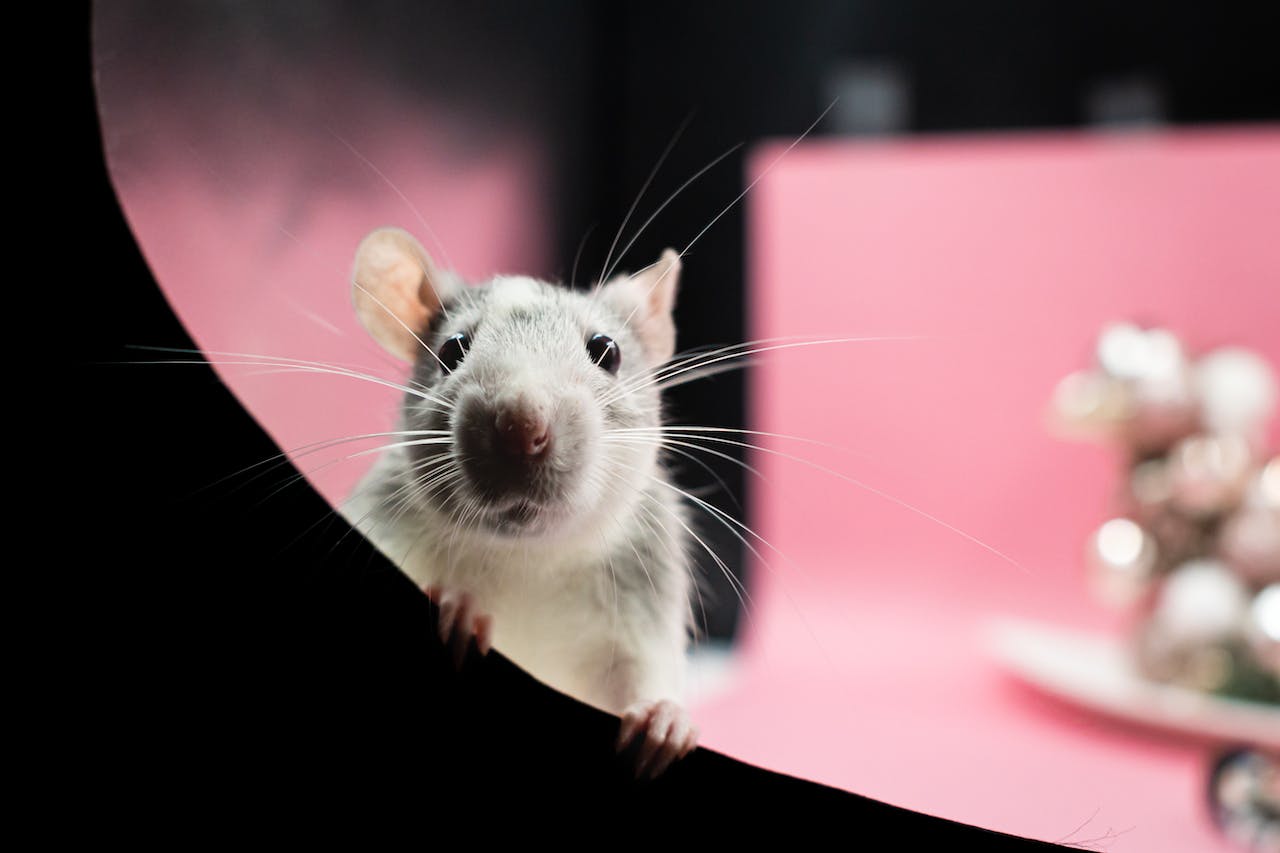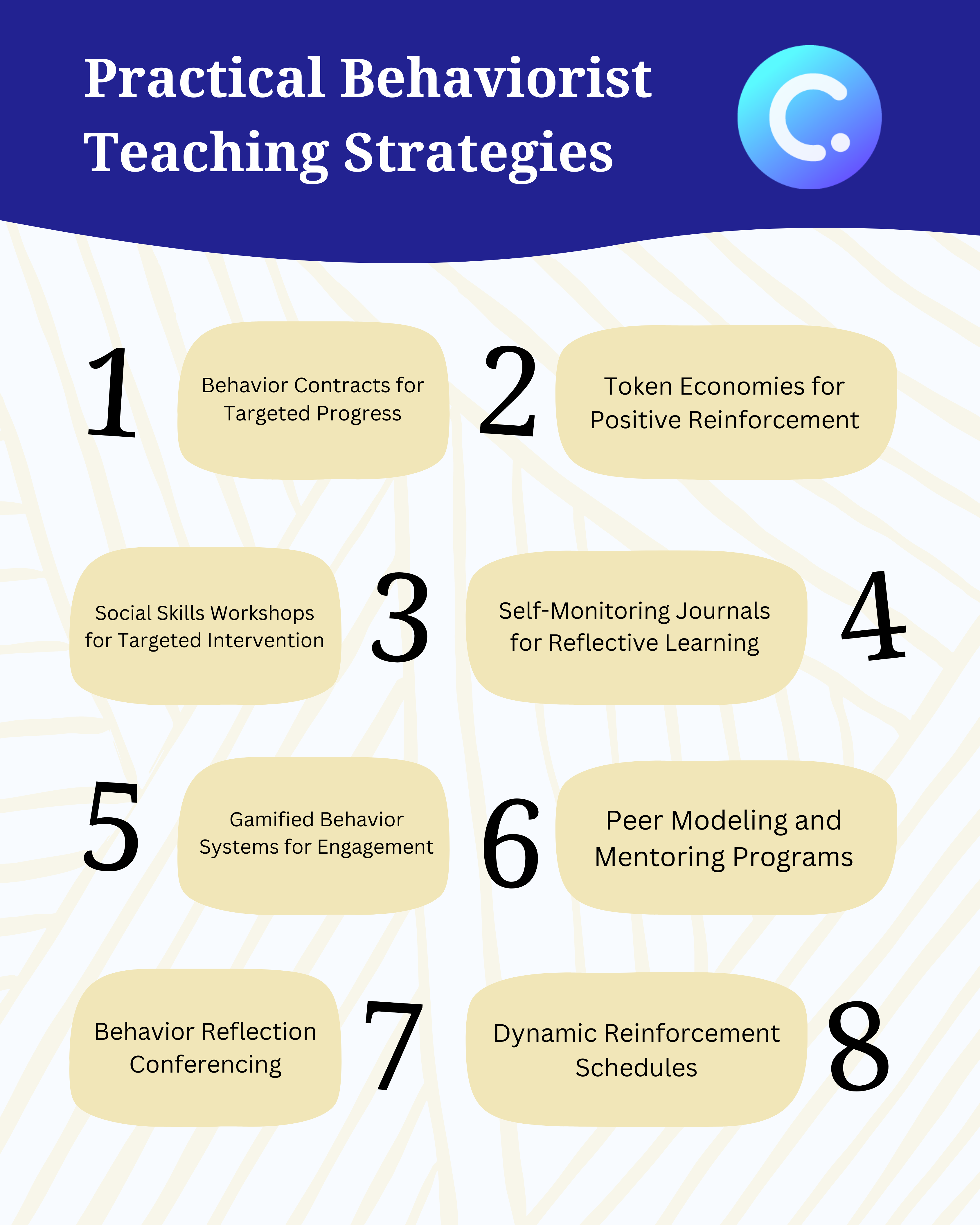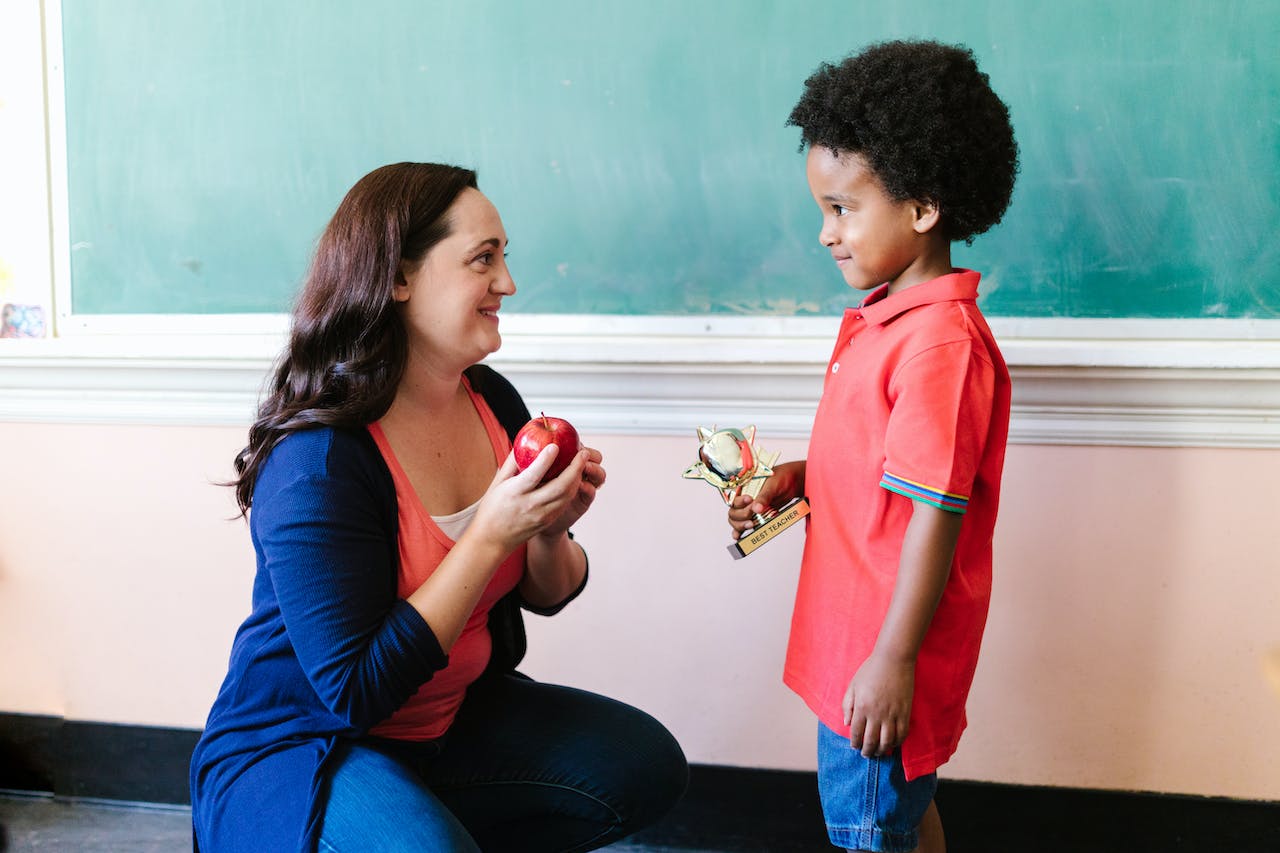Teaching is a rollercoaster of highs and, let’s face it, a few hair-raising lows. Lesson plans can sometimes feel like more of a suggestion and the struggle to keep focus is real. We’ve all been there, chalk-stained warriors facing the daily battle of capturing attention and fostering an environment where learning efficiently thrives. If you’re nodding your head, you’re not alone. The magic trick to decode these classroom mysteries? Behavioral Learning Theory.
From the yawns of boredom to the occasional classroom chaos that makes you question your teaching style choices, this theory is here to help. So, if you’re ready to switch up your teaching game, let’s dive into the practical world of Behavioral Learning Theory – no magic tricks, just real strategies for a more engaging and enjoyable classroom. Ready to make teaching a bit less of a rollercoaster? Let’s get started.
We Will Explore:
What is Behavioral Learning Theory? (Less the Jargons)
What is Behavioral Learning Theory?
Behavioral Learning Theory is like the GPS for understanding why students behave the way they do. Think of it as uncovering the ‘why’ behind the ‘what’ in your classroom. It’s rooted in two big names – Pavlov and Skinner. Pavlov? Yes, the bell-and-dog guy. Skinner? The one who turned rats into psychology superstars.
Their ideas revolve around how we learn through experiences and consequences. No need for a psychology degree; it’s more like understanding the ABCs – Antecedent, Behavior, Consequence. So, when you see a student acting up, it’s not just chaos; there’s a method behind the madness.
Importance of Understanding Behavioral Learning for Teachers
Why should teachers bother with Behavioral Learning Theory? Here’s the lowdown:
- Cracking the Behavior Code: Ever felt like you’re in a constant battle for attention? Behavioral Learning Theory equips you with the tools to decode why students act the way they do, making classroom management a breeze.
- Personalized Teaching: It’s not a one-size-fits-all world. Understanding behavioral patterns allows you to tailor your teaching approach, catering to the unique needs of each student.
- Nip Problems in the Bud: Spotting behavioral issues early means you can address them before they snowball into major disruptions. It’s like preventive medicine for your classroom.
- Boosting Engagement: By tapping into the principles of rewards and consequences, you can create an environment where students are not just present but actively engaged in the learning process.
The Role of Behavioral Learning in Shaping Classroom Dynamics

To make it more digestible – say your classroom is like a mini-society, and Behavioral Learning Theory is the invisible architect. Here’s how it shapes the dynamics:
⏰ Scenario Time:
Imagine your classroom as a bustling city. Behavioral Learning Theory is the urban planner, setting the rules and creating the infrastructure. When positive behaviors are rewarded, it’s like planting green spaces in your city – it flourishes. On the flip side, addressing negative behaviors is akin to fixing potholes – essential for a smooth ride.
Blueprint for Success: Behavioral Learning Theory isn’t just about dealing with problems; it’s about building a blueprint for success. It influences how students interact, how you manage the class, and ultimately, it shapes the culture of your educational city.
💡 In Short:
It’s the unseen director behind the scenes, influencing the plot, setting the stage, and ensuring that your classroom runs like a well-oiled machine. Because let’s face it, even educational cities need a plan to thrive.
Understanding Behavioral Learning Theory in Pedagogy
Key Principles and People Behind
1. Pavlov’s Classical Conditioning

Behavioral Learning Theory, rooted in the groundbreaking work of Ivan Pavlov, revolves around the concept of classical conditioning. In the early 20th century, Pavlov conducted experiments with dogs, noting that they could be trained to associate a neutral stimulus (like a bell) with a specific response (salivation) through repeated pairing with a naturally occurring stimulus (food). This fundamental principle illustrates how behaviors can be learned through associations, a concept foundational to understanding student responses in the classroom.
2. Skinner’s Operant Conditioning

B.F. Skinner expanded the realm of Behavioral Learning Theory with his work on operant conditioning. Unlike classical conditioning, operant conditioning focuses on the consequences of behavior. Skinner’s experiments involved reinforcing or punishing behaviors to either increase or decrease their occurrence. This principle is crucial for teachers seeking effective classroom management strategies. By employing positive reinforcement for desired behaviors and implementing appropriate consequences for undesired behaviors, educators can shape and modify student conduct.
These key principles provide a solid foundation for you to comprehend how behaviors are acquired, modified, and influenced in the learning environment, offering a systematic approach to address various aspects of classroom dynamics.
Behavioral Learning Theory In-Depth
Behavioral Learning Theory posits that behaviors are acquired and modified through a process of association, reinforcement, and consequences. The acquisition of behavior involves linking a neutral stimulus with a response through repeated exposure, as demonstrated in classical conditioning. Once a behavior is established, its modification occurs through operant conditioning, where the consequences of the behavior, whether positive or negative, influence its future occurrence. In simpler terms, students learn by associating actions with outcomes – whether it’s receiving praise for a correct answer or facing a consequence for disruptive behavior.

Positive Reinforcement
Positive reinforcement involves rewarding desired behaviors to encourage their repetition. Think of it as a simple cause-and-effect mechanism. For instance, praising a student for active participation in class fosters a positive association with engagement, making it more likely for the student to participate in the future.
Negative Reinforcement
Conversely, negative reinforcement centers on removing an aversive stimulus to reinforce a behavior. It’s about creating a more comfortable learning environment. For example, alleviating a student from a challenging task once they’ve mastered a concept reinforces the idea that understanding leads to a more positive experience.
Punishment
Punishment, when used judiciously, is not about instilling fear but about refining undesired behaviors. It involves consequences like a brief time-out or a loss of privilege for disruptive actions. The goal is to establish clear boundaries that contribute to a productive and respectful learning atmosphere.
Comparison to Other Learning Theories
Understanding Behavioral Learning Theory becomes more insightful when placed in context with other prominent learning theories. Here’s a concise exploration of how it aligns and diverges with key educational perspectives:
| Other Learning Theory | Behavioral Learning Theory | |
| Cognitive Learning Theory | Keywords: cognition and cognitive processes Cognitive Learning Theory delves into mental processes like memory and critical thinking. It’s not just about what students do but also about understanding how they think. For instance, when teaching a complex concept, Cognitive Learning Theory might stress the importance of understanding the underlying concept (cognition). | Keywords: repetitive processes Behavioral Learning Theory operates on observable behaviors, emphasizing external stimuli and responses. It may prioritize repetitive practice to reinforce behaviors, in contrast to Cognitive Learning Theory’s focus on understanding mental processes. |
| Social Learning Theory | Keywords: social environment, experiences Social Learning Theory extends the discussion beyond individual behaviors. It acknowledges the influence of the social environment and role models on learning. In the classroom, this means recognizing that students learn not only from direct experiences but also by observing and imitating others. This broadens the perspective to include social dynamics. | Keywords: external stimuli and factors Behavioral Learning Theory emphasizes the impact of external stimuli on behavior, while Social Learning Theory expands this by including social influences and observational learning. It recognizes the importance of role models and the social environment in shaping behaviors. |
| Constructivist Learning Theory | Keywords: internal reflection and factors Constructivism shifts the spotlight from external influences to the learner’s active role in constructing knowledge. Constructivist Learning Theory emphasizes that individuals build understanding through their experiences, interactions, and reflections. It’s about connecting new information to existing knowledge, promoting a deeper understanding. | Keywords: external stimuli and factors Behavioral Learning Theory, in contrast to Constructivist Learning Theory, places more emphasis on external factors like reinforcement in shaping behaviors. While Constructivism highlights active construction of knowledge, Behavioral Learning Theory focuses on the influence of external stimuli on observable actions. |
| Humanistic Learning Theory | Keywords: intrinsic motivation and rewards Humanistic Learning Theory zooms in on personal growth and self-directed learning. It adds a layer by emphasizing intrinsic motivation and autonomy. It’s about acknowledging that students aren’t just passive recipients of rewards or punishments; they have a drive for self-actualization. | Keywords: external reinforcement Behavioral Learning Theory, with its focus on external reinforcements, contrasts with Humanistic Learning Theory’s emphasis on intrinsic motivation and autonomy. While Behavioral Learning Theory uses external stimuli to guide behavior, Humanistic Learning Theory recognizes students’ internal drive for personal growth and self-directed learning. |
8 Practical Behaviorist Teaching Strategies for the Perfect Classroom Behaviors

1. Behavior Contracts for Targeted Progress
What it is: Behavior contracts provide a structured approach to address specific behavioral goals for individual students. This strategy emphasizes the connection between behavior and consequences, a key concept in Behavioral Learning Theory.
How to do it: Identify a student struggling with disruptive behavior. Collaborate with the student to create a behavior contract outlining clear expectations, positive reinforcement for meeting those expectations, and consequences for not meeting them. Regularly review and adjust the contract based on the student’s progress.
Explore this list of surface management techniques and contingency plans for a more targeted classroom management.
2. Token Economies for Positive Reinforcement
What it is: Token economies introduce a token system where students earn tokens for positive behaviors, and they can later exchange these tokens for rewards. This strategy aligns with the Behavioral Learning Theory’s emphasis on positive reinforcement.
How to do it: Implement a token economy in the classroom. Define specific positive behaviors (e.g., active participation, completing assignments on time) and assign tokens for each instance. Students can accumulate tokens to trade for rewards like extra break time or choosing a fun classroom activity.
Tokens can be in any form, tangible or intangible. With the rise of EdTech tools around, it's 10x easier to kickstart a token system in the classroom paired with technology. The top-of-mind choice? ClassPoint. ClassPoint is a direct add-in to Microsoft PowerPoint that features an engineered point system where you can award stars to students to which they can collect to rank up to different levels with corresponding badges. And yes, do all this right inside PowerPoint. How convenient?
3. Social Skills Workshops for Targeted Intervention
What it is: For students struggling with social interactions, targeted social skills workshops can provide explicit instruction and practice. This strategy aligns with the Behavioral Learning Theory’s focus on addressing specific behaviors through direct intervention.
How to do it: Identify a group of students facing challenges in social interactions. Conduct workshops that teach and practice essential social skills, such as active listening, turn-taking, and conflict resolution. Reinforce positive social behaviors through role-playing and real-life scenarios.
Check out this conflict resolution expert guide for teachers.
4. Self-Monitoring Journals for Reflective Learning
What it is: Self-monitoring journals empower students to reflect on their own behavior. This strategy aligns with the Behavioral Learning Theory’s emphasis on self-regulation and awareness.
How to do it: Provide students with self-monitoring journals where they record their behavior throughout the day. Encourage them to note positive actions, areas for improvement, and reflections on why certain behaviors occurred. Periodically review these journals together to reinforce self-awareness and goal-setting.
Easily save student journals by running a ClassPoint Short Answer activity during every journaling session. Use your handy partner, PowerPoint, to collect submissions from students. This way, you can save all of your students' submissions in one place that you could easily go back to.
5. Gamified Behavior Systems for Engagement
What it is: Gamification introduces game elements into the classroom to make behavior management engaging. This strategy aligns with Behavioral Learning Theory by leveraging positive reinforcement and providing a structured framework for behavior modification.
How to do it: Create a gamified system where students earn points or badges for demonstrating positive behaviors. Define levels, rewards, and challenges tied to these achievements. This not only encourages healthy competition but also aligns with the Behavioral Learning Theory’s principles of reinforcement and structured consequences.
Overwhelmed with all the gamification tool options out in the market? No worries. We curated the top gamification tools teachers all around the world love and adore.
6. Peer Modeling and Mentoring Programs
What it is: Utilize peer modeling to demonstrate positive behaviors and establish mentoring programs to support struggling students. This strategy aligns with Behavioral Learning Theory’s emphasis on observational learning and social influence.
How to do it: Identify students who consistently exhibit positive behaviors. Pair them with peers who may need support in certain areas. Through regular interactions, the mentee observes and learns from the positive behaviors of their mentor, creating a supportive social learning environment.
Use ClassPoint's grouping feature to award stars to groups on-the-go!
7. Behavior Reflection Conferencing
What it is: Behavior reflection conferences provide students with the opportunity to reflect on their actions, consequences, and alternative behaviors. This strategy aligns with the Behavioral Learning Theory’s focus on understanding the relationship between behavior and outcomes.
How to do it: After a significant behavioral incident, hold a one-on-one behavior reflection conference with the student. Discuss the behavior, its impact, and alternative choices. Encourage the student to reflect on their actions and collaboratively develop a plan to address and improve their behavior moving forward.
Try this classroom management plan template for a well-managed classroom.
8. Dynamic Reinforcement Schedules
What it is: Implement dynamic reinforcement schedules to maintain engagement and motivation. This strategy aligns with Behavioral Learning Theory’s principles of reinforcement and emphasizes the importance of variable schedules in behavior modification.
How to do it: Instead of providing a fixed schedule for positive reinforcement, introduce variability. For example, initially reinforce positive behavior consistently, then shift to a variable schedule where reinforcement occurs unpredictably. This keeps students motivated as they never know when their positive behavior might be rewarded.
Positive Outcomes of Behaviorist Teaching Strategies for Students
In embracing Behavioral Learning Theory, educators unlock a myriad of benefits that extend beyond academic achievement. This approach cultivates a positive and nurturing educational environment, fostering students’ holistic development. Here are some unique positive outcomes for learners:

✨ Enhanced Behavior Management
Implementing Behavioral Learning Theory provides educators with effective tools for managing student behavior, creating a conducive space for learning and growth.
🌱 Personalized Development Plans
Tailored interventions based on Behavioral Learning Theory allow educators to create personalized plans for each student, addressing their specific needs and promoting individualized growth.
🧠 Improved Self-Awareness
Through strategies like self-monitoring and reflection, students develop a heightened sense of self-awareness, understanding their behaviors and their impact on the learning environment.
🌐 Social and Emotional Growth
The emphasis on social skills workshops and peer modeling contributes to students’ social and emotional development, fostering empathy, cooperation, and positive relationships.
🌈 Positive Reinforcement Culture
Behavioral Learning Theory establishes a positive reinforcement culture in the classroom, where students are acknowledged and rewarded for their positive behaviors, leading to increased motivation.
💡 Practical Life Skills
By incorporating real-world scenarios in behavior reflection conferences, students not only learn academic content but also gain valuable life skills, such as conflict resolution and decision-making.
🚀 Lifelong Learning Habits
The strategies aligned with Behavioral Learning Theory instill lifelong learning habits, encouraging students to take ownership of their learning journey and fostering a growth mindset.
Food for Thought
Indeed, Behavioral Learning Theory is like a superpower for educators. It helps us understand each student and use special tricks to make good behaviors stick. More often than not, it’s not just about rules; it’s about creating a happy place where learning and growing go hand in hand.
So, as we dive into the Behavioral Learning Theory, we’re basically becoming superheroes in the classroom. We’re choosing understanding over strictness and giving each student their own learning adventure. Every time we cheer for good stuff and help when things get tricky, we’re building a cool story of learning that each student gets to be a part of.
